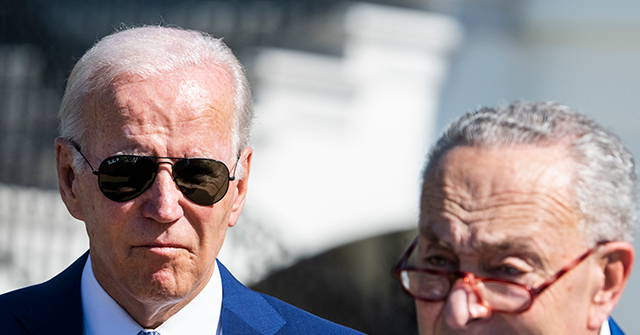

Inflation in the United States rose at 8.5 percent in July compared with a year earlier, the Department of Labor said Wednesday.
Compared with a month earlier, the Bureau of Labor Statistics’ Consumer Price Index was flat with the month prior.
Economists had expected CPI to rise at an annual rate of 8.7 percent, down from 9.1 percent in June. They expected a month-over-month increase of 0.2 percent, a sharp decline from the 1.1 percent recorded in June.
Inflation has hit American families hard by raising prices for everyday necessities like food, gasoline, housing, transportation, and utilities. A sizeable decline in the price of gasoline in July, which retreated from record highs hit the prior month, helped bring down the overall rate of inflation. The index for gasoline fell 7.1 percent in July. Compared with a year ago, the gas index is up 44 percent.
Economists look to a sub-category of inflation that excludes food and fuel prices, known as core inflation, as a better guide to future inflation than the headline number. This was up 5.9 percent in July compared with 12 months earlier, even with the 5.9 percent recorded in June. For the month, core prices rose 0.3 percent after rising 0.7 percent in June. Economists had expected core inflation to rise 6.1 percent year over year and 0.5 percent compared with June.
Despite the slowdown in core and headline inflation, inflation at the grocery store continues to rise. Prices were up 1.3 percent compared with a month earlier and 13.1 percent compared with a year ago.
Services prices excluding energy services rose 0.4 percent, down from the 0.7 percent rise in the prior month. Compared with a year ago, services are up 5.5 percent. Both were lower than expected.
The price of goods outside of food and energy rose 0.2 percent compared with a month earlier. Compared with a year ago, core goods prices are up seven percent.
This was the 14th straight month of inflation running higher than five percent, meaning this year’s price increases are building on top of the decades high increases of last year.
Although critics of President Donald Trump’s tariffs on goods from China and imported steel and aluminum claimed the levies would raise prices, consumer prices remained low throughout his administration. Trump’s tariffs did not raise prices for consumers. Instead, they were absorbed by Chinese producers and exporters and the profit margins of U.S. businesses.
Inflation only began to accelerate last March after years in which it typically came in below the Fed’s two percent target. The Fed had kept interest rates low in 2021 although the economy was recovering at a faster than expected rate. What’s more, the Biden administration pushed through billions of dollars of deficit spending in the American Rescue Plan. These combined to fuel demand for goods faster than supplies could expand, pushing up prices.
Federal Reserve chief Jerome Powell, following the advice of many of the economists on the central bank’s staff, believed last year that inflation was due to transitory factors. Fed officials forecast that inflation would fall in the latter half of 2021, predicting that supply chains would unsnarl and a rebalancing of consumer demand from goods to services would relieve pricing pressure. The Biden administration, under the tutelage of former Fed chair and now Treasury Secretary Janet Yellen, largely followed suit and continued to press for even more spending.
This government consensus proved to be offbase. Inflation continued to soar, hurting the credibility of the Biden administration and the central bank when it came to inflation. Late last year, Fed officials dropped the word “transitory” from their vocabulary and began signaling that they would raise interest rates this year. The Fed raised its rate target in March by 25 basis point, 50 basis points in May, and 75 basis points in June and July, the largest rate hikes since 1994. The Fed will not meet again until September. Prior to Wednesday’s CPI release, derivatives prices implied just under a 70 percent chance that the Fed would raise rates by another 75 basis points at that meeting. After the July CPI numbers were released, the odds shifted to show a 66.5 percent chance of a fifty basis point increase, which would up the range at 2.75 percent to three percent.
Consumer sentiment, as measured by the widely followed University of Michigan index, sunk to the worst level ever in June and was little changed in July. The economy shrank in both the first and second quarters this year, prompting a debate over whether or not two consecutive quarters of contraction should be considered a recession. The labor market, meanwhile, has proved incredibly resilient, adding an average of over 450,000 a month. In July, the economy added 528,000 jobs, more than twice what was expected, and the unemployment rate fell to 3.5 percent, matching the prepandemic low.
Fed officials have said they believe that they will need to cool down the labor market in order to bring down the rate of inflation. Powell has spoken about bringing down the number of job openings from the historically elevated levels that have seen close to two vacant jobs for every unemployed person in the U.S. Economists have been vigorously debating whether the market can be cooled without significantly raising the unemployment rate. Recent polls suggest that most Americans do not expect a higher rate of unemployment next year.
This week Democrats in the U.S. Senate passed a climate and spending bill dubbed the Inflation Reduction Act even though most analysts, including the influential Penn Wharton Model and the Congressional Budget Office, do not believe the legislation will significantly reduce inflation. In fact, the bill expands the budget deficit in the near-term, which may raise inflationary pressures, only shrinking deficits five years from now. No Republicans voted for the bill. It is expected to pass the House this week and be signed into law by Biden shortly afterward.






